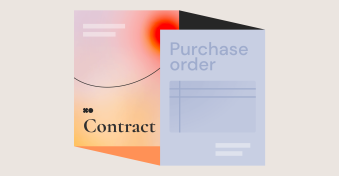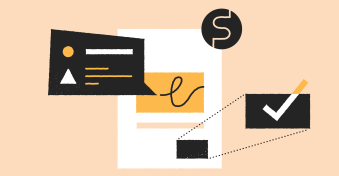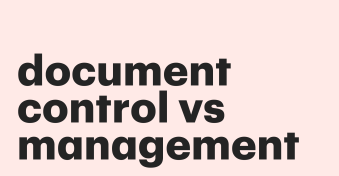Both purchase orders and purchase requisitions sound very similar. They’re both essential processes, but what exactly is the difference?
In this article, we’ll compare purchase requisition vs purchase order and the role of each in the workplace.
Key takeaways
- A PR is a process designed to approve internal purchase requests. A PO is the process of buying an item or a service.
- Both PR and PO bring a number of benefits to the purchasing process. The biggest example is for record-keeping purposes.
- The payment process can become much more streamlined and efficient with automation software.
What is the difference between a purchase requisition (PR) and a purchase order (PO)?
The terms of purchase requisition (PR) and purchase order (PO) are often used interchangeably.
There’s no denying that both apply to similar areas; both are essential for cost management and auditing.
There is, however, a clear difference between PR and PO.
With PR, an employee is requesting permission to buy goods or services.
This could be new electronic equipment or anything else needed to support the running of a team.
They’ll file a purchase requisition form, which is then considered by the relevant manager.
If approved, the employee can then create a purchase order. This allows them to buy the items they need.
PR and PO similarities
The most apparent similarity is that both form a part of the internal purchasing process.
New items cannot be procured without filing a PR and a PO.
Both documents are also helpful for auditing purposes. They leave clear records of any money spent and the purposes of each purchase.
What is a purchase requisition?
Let’s begin by looking at the purchase requisition meaning. A PR is the first step in any internal business purchases.
To reiterate, a purchase requisition does not allow a product to be purchased.
It’s worth remembering that not every purchase requires a PR.
Low-cost items, like new stationery, can be purchased when needed.
Generally, a monetary threshold is set by an organization. If the payment exceeds the threshold, a PR is needed.
Every PR should be backed with precise information.
Most importantly, how much will an item cost, and which department will it be delivered to?
Information on a purchase requisition form
You should now be able to define purchase requisition.
Let’s look at some information that should be included on a purchase requisition form.
- The name of the buyer’s department
- The buyer’s contact information
- A description of the items or services being purchased
- The number of items being purchased
- The anticipated price of an item
- The name of the supplier
- The delivery date that was requested
How important is a purchase requisition form?
A purchase requisition form is an essential item for various reasons. Perhaps most significantly, a PR form is useful for tax purposes.
It helps to create a clear paper trail, minimize the risk of fraud, and keep your business above board.
Additionally, a PR form helps improve transparency within the payment process.
It ensures that there is clear documentation logging all purchases.
There’s no confusion surrounding what money is going out and why.
How does a PR work? Four benefits
You should now have a clearer idea of what PR is and its place in the payment process.
But what other benefits can be attributed to this approach?
Below are some of the top advantages of PR.
- Greater control over spending – Keeping a strong grip on spending is crucial due to increasingly uncertain markets. With a stringent approach to PR, businesses can ensure that only purchases that bring value are approved.
- Avoid duplicate orders – A simple miscommunication can see the same product being ordered twice. PR establishes a clear record of purchases, minimizing the risk of duplicate orders.
- Improve inventory management – You can know what products are coming in and when. This makes the process of managing inventory much easier.
- Prevent unauthorized purchases – There’s always a risk of underhand activity by employees. PR ensures that the use of an organization’s funds is first approved.
Process steps for purchase requisition
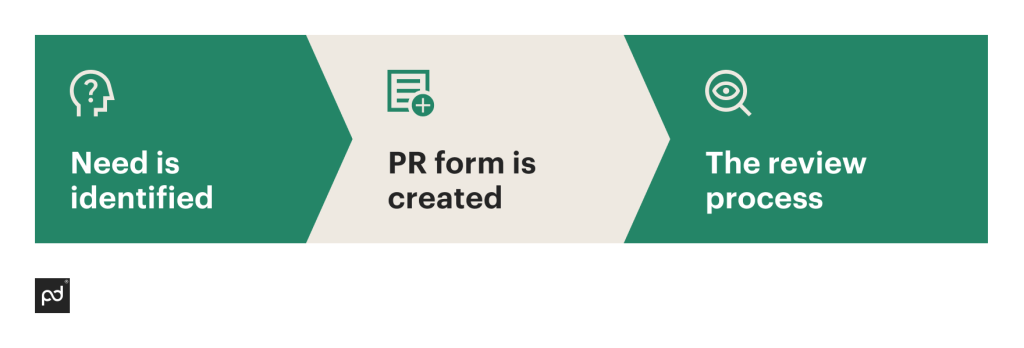
There’s no denying that PR is important, but how does the process work?
Let’s look at all the steps involved in PR.
A need is identified
A department, team, or individual employee recognizes that a new item or service is needed.
This could be anything ranging from new computer equipment to better software.
A PR form is created
Before a purchase can be made, a PR form must be completed and sent to the relevant department.
This should include the information listed earlier.
A PR form can be created manually or using purchase requisition templates.
The review process
After the PR form is submitted, it will go through a review process. The procedure for this stage will differ from organization to organization.
Some businesses hand responsibilities to a senior manager. Others create dedicated departments to handle acquisitions.
We’ll explore the next steps in the process in the ‘Process steps for purchase order’ section.
Three best practices for creating and managing purchase requisitions
The PR process sounds simple. Unfortunately, it’s also very easy to get wrong; processes become muddled, and confusion ensues.
Here are some steps to make sure your PR is handled successfully.
1. Create a space for PR storage
Collecting PR forms is a valuable step, but it needs to be handled with care.
Traditional storage methods, like filing cabinets, can work on a small scale.
However, as you start to gather more forms, things can quickly get confused.
Essential documents might get mislaid, or you could end up with the wrong file version.
When an audit comes along, you might not be able to find the documents you need.
Cloud storage is a simple solution that keeps all your PR documents in a centralized space.
Moreover, it can be accessed from anywhere with an internet connection.
This means employees can access PR files even when out of the office.
2. Invest in an e-procurement system
The manual purchasing process can easily get confused. This could be due to miscommunication or simply human error.
To avoid these issues, you need a birds-eye-view over the entire process.
Unfortunately, this is very difficult to achieve through manual means.
Luckily, there’s a solution to the issue: An e-procurement system. This is software designed to streamline the payment process.
It covers all stages from PR to PO and beyond. The right system can help with order tracking, inventory management, and more.
3. Introduce internal procurement rules
Every organization should have clear sets of procurement rules. Rules help to make the purchasing process smoother.
Employees have a clearer idea of internal procurement, and the PR team is less bogged down with incorrect requests.
When outlining your procurement rules, consider the following factors:
- What can and cannot be purchased by employees?
- What payment terms are deemed acceptable by your organization?
- Which suppliers should employees approach?
Purchase requisition example
Let’s imagine that the HR department is currently using a manual approach to handle legal documents for business.
They want to move on from their old, admin-intensive approach to an automated process.
But first, they need to create a PR form to request the software.
They include the following information:
- Department name – In this instance, HR.
- Contact information – The email address of the HR manager.
- A description – Detailing the specifics of their chosen automated solution.
- Quantity – Their requested automation package.
- The price
- Supplier name – e.g., ‘PandaDoc’
- Delivery date – Most likely an irrelevant factor for software. Other factors, like demoing and implementation, might be considered in this case.
There form is submitted and, later, approved. They can continue to the next stage of the payment process: the PO form.
What is a purchase order?
A PO is a legally binding document between the buyer and the seller.
The buyer is committing to purchasing the requested item.
The document protects the seller from non-payment risk – a PO is always filed before a bill is sent.
Information on a purchase order form
A PO includes the following information:
- The purchase order number
- The agreed terms of payment
- The items being purchased by the organization
- Shipping instructions
- Information relating to invoicing
Why do you need a purchase order form?
A PO form is a crucial part of the purchasing process.
Firstly, a PO is a legally binding contract that protects both parties. It avoids any disagreements later down the line.
All terms are laid on the table from the get-go.
When comparing the similarities of a purchase requisition vs purchase order, one related benefit is record keeping.
A PO ensures that all purchases are logged and demonstrates that correct procedures have been followed.
How does a PO work? Four benefits
Hopefully, you now have a better idea of why a PO is essential.
If not, here are some of the top benefits.
- Reduces the risk of receiving the wrong product – Receiving the wrong item can be an extremely frustrating experience. A PO lists the items requested from the buyer, helping to prevent mistakes.
- Helpful for tax purposes – Like a PR, a PO is a helpful record for tax purposes. You have simple access to purchase data, which can be shared easily with authorities.
- Offers legal protection – A PO ensures that a supplier is legally obligated to fulfill an order correctly. If they don’t send the correct number or specification of items, you can demand another delivery.
- Easier financial planning – A PO helps to keep track of where your money is going. This helps to make more informed budgeting decisions.
Process steps for purchase order
It’s clear that a purchase order is equally important as a purchase requisition.
But how does the PO process work? Let’s a closer look at each stage.
A PO form is created
A department, team, or individual has sent off a PR form to request a new item or service.
Assuming that this has been approved, a purchase order form is created listing details of the order.
The team might create this manually or use a purchase order template to save time.
Once created, the PO is sent to the relevant authority and approved. The PO can now be sent to a supplier.
The supplier evaluates the PO
The supplier will take time to examine the PO.
They may decide that certain terms are unacceptable and return the document with amendments.
Payment is issued
If the supplier is happy with the PO, they send a bill to the buyer.
Payment can then be issued to the supplier.
The buyer may then be provided with an estimated delivery date.
Three best practices for creating and managing purchase orders
To be effective, the PO processes must run smoothly and efficiently.
Unfortunately, this isn’t the case with all business.
With that in mind, let’s look at some best practices for creating and managing purchase orders.
Keep clear records of suppliers
FInding a supplier isn’t always a simple process. Finding a vendor with the item you need isn’t often enough.
Not only do you need to be assured of quality, but also find the right price.
Creating a vendor database helps to speed up this process.
When you find a vendor that you’re happy with, they can be added to the database.
This way, the next time you are looking for a similar item you can access your database and order again.
Use a purchase approval system
Having to manually approve each purchase can be very time-consuming.
A purchase approval system is a way of mitigating some of the admin and getting orders off more quickly.
With this system, instead of assessing each PO form manually, you create records of previous approvals.
Perhaps there was a certain order that was given approval. The system will automatically approve similar future orders.
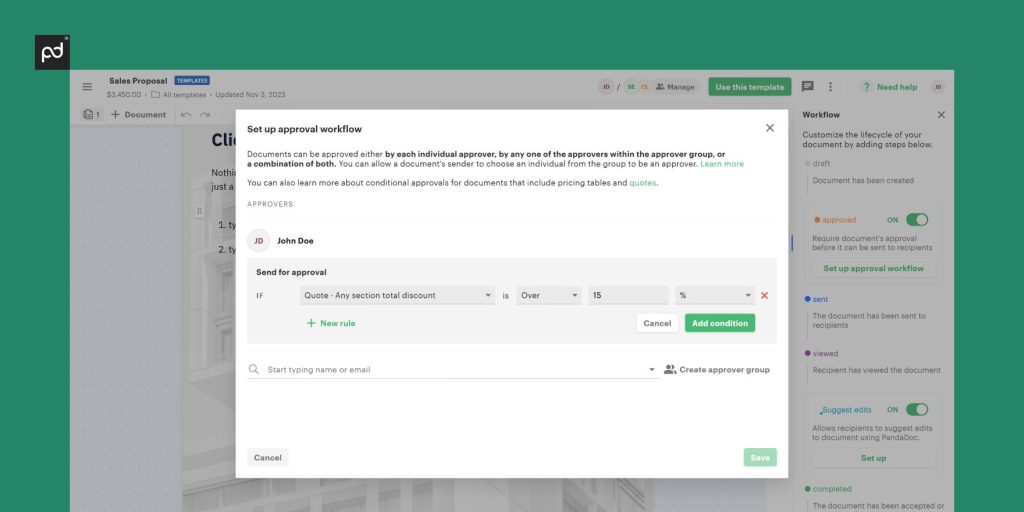
Introduce a cloud-based system
We’ve already talked about how the cloud can help PR. However, the cloud is equally helpful for PO management.
Cloud-based procurement can help to introduce a more streamlined ordering process.
This includes:
- Fraud is easier to identify and address
- PO forms are approved more quickly
- Greater visibility over the purchasing process
Purchase order example
To demonstrate the part that PO plays in the purchase order and requisition process, let’s go back to our earlier example of the HR department requesting new software.
At this stage, their PR form has been approved and they’re now ready to create a PO form.
They include the following information:
- Their PO number
- Some suggested payment terms
- The name of the software package being purchased
- Details relating to invoicing
The PO form is internally reviewed before being sent to the supplier.
The supplier looks at the document but has some issues.
They send back the form with new suggested payment terms.
After a little more back and forth, both parties are satisfied with the order.
The HR department then begins the process of introducing the software package.
Which comes first, purchase requisition or purchase order?
The purchase requisition always comes before the purchase order.
It’s an essential process for ensuring that purchases meet the needs of the business.
Of course, as mentioned, there are scenarios where a PR is not needed.
Usually, when it comes to low-cost items the process will begin with the PO form.
Automate the purchase requisition and purchase order process using PandaDoc software
When comparing purchase order vs purchase requisition, it’s clear that the two are not interchangeable.
They should be used in tandem to support an efficient and well-documented payment process.
Of course, ensuring both effective PR and PO isn’t easy.
We’ve looked at some of the reasons why a manual approach simply won’t cut it.
Your business might find itself overwhelmed with admin and tangled internal processes.
Luckily, PandaDoc automation software represents a clear alternative.
With PandaDoc, you can optimize agreement workflows and maximize revenue.
With features like real-time access to approvals, comments, and version tracking, you can stay on top of PR and PO.
But don’t take our word for it. Why not try a 14-day trial today?
Disclaimer
PandaDoc is not a law firm, or a substitute for an attorney or law firm. This page is not intended to and does not provide legal advice. Should you have legal questions on the validity of e-signatures or digital signatures and the enforceability thereof, please consult with an attorney or law firm. Use of PandaDoc services are governed by our Terms of Use and Privacy Policy.
